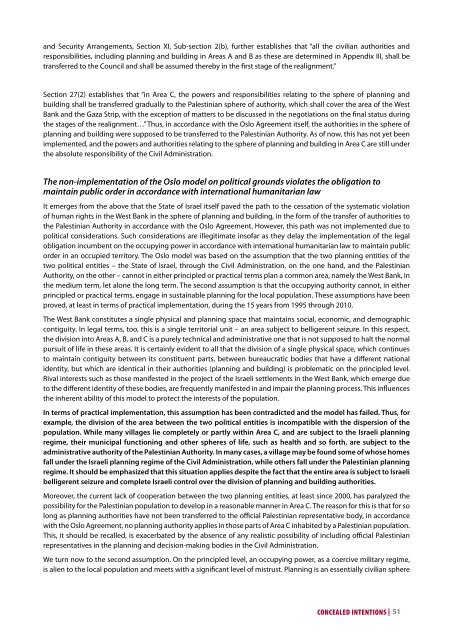Concealed Intentions- JLAC-.pdf
Concealed Intentions- JLAC-.pdf
Concealed Intentions- JLAC-.pdf
Create successful ePaper yourself
Turn your PDF publications into a flip-book with our unique Google optimized e-Paper software.
and Security Arrangements, Section XI, Sub-section 2(b), further establishes that “all the civilian authorities and<br />
responsibilities, including planning and building in Areas A and B as these are determined in Appendix III, shall be<br />
transferred to the Council and shall be assumed thereby in the first stage of the realignment.”<br />
Section 27(2) establishes that “in Area C, the powers and responsibilities relating to the sphere of planning and<br />
building shall be transferred gradually to the Palestinian sphere of authority, which shall cover the area of the West<br />
Bank and the Gaza Strip, with the exception of matters to be discussed in the negotiations on the final status during<br />
the stages of the realignment…” Thus, in accordance with the Oslo Agreement itself, the authorities in the sphere of<br />
planning and building were supposed to be transferred to the Palestinian Authority. As of now, this has not yet been<br />
implemented, and the powers and authorities relating to the sphere of planning and building in Area C are still under<br />
the absolute responsibility of the Civil Administration.<br />
The non-implementation of the Oslo model on political grounds violates the obligation to<br />
maintain public order in accordance with international humanitarian law<br />
It emerges from the above that the State of Israel itself paved the path to the cessation of the systematic violation<br />
of human rights in the West Bank in the sphere of planning and building, in the form of the transfer of authorities to<br />
the Palestinian Authority in accordance with the Oslo Agreement. However, this path was not implemented due to<br />
political considerations. Such considerations are illegitimate insofar as they delay the implementation of the legal<br />
obligation incumbent on the occupying power in accordance with international humanitarian law to maintain public<br />
order in an occupied territory. The Oslo model was based on the assumption that the two planning entities of the<br />
two political entities – the State of Israel, through the Civil Administration, on the one hand, and the Palestinian<br />
Authority, on the other – cannot in either principled or practical terms plan a common area, namely the West Bank, in<br />
the medium term, let alone the long term. The second assumption is that the occupying authority cannot, in either<br />
principled or practical terms, engage in sustainable planning for the local population. These assumptions have been<br />
proved, at least in terms of practical implementation, during the 15 years from 1995 through 2010.<br />
The West Bank constitutes a single physical and planning space that maintains social, economic, and demographic<br />
contiguity. In legal terms, too, this is a single territorial unit – an area subject to belligerent seizure. In this respect,<br />
the division into Areas A, B, and C is a purely technical and administrative one that is not supposed to halt the normal<br />
pursuit of life in these areas. It is certainly evident to all that the division of a single physical space, which continues<br />
to maintain contiguity between its constituent parts, between bureaucratic bodies that have a different national<br />
identity, but which are identical in their authorities (planning and building) is problematic on the principled level.<br />
Rival interests such as those manifested in the project of the Israeli settlements in the West Bank, which emerge due<br />
to the different identity of these bodies, are frequently manifested in and impair the planning process. This influences<br />
the inherent ability of this model to protect the interests of the population.<br />
In terms of practical implementation, this assumption has been contradicted and the model has failed. Thus, for<br />
example, the division of the area between the two political entities is incompatible with the dispersion of the<br />
population. While many villages lie completely or partly within Area C, and are subject to the Israeli planning<br />
regime, their municipal functioning and other spheres of life, such as health and so forth, are subject to the<br />
administrative authority of the Palestinian Authority. In many cases, a village may be found some of whose homes<br />
fall under the Israeli planning regime of the Civil Administration, while others fall under the Palestinian planning<br />
regime. It should be emphasized that this situation applies despite the fact that the entire area is subject to Israeli<br />
belligerent seizure and complete Israeli control over the division of planning and building authorities.<br />
Moreover, the current lack of cooperation between the two planning entities, at least since 2000, has paralyzed the<br />
possibility for the Palestinian population to develop in a reasonable manner in Area C. The reason for this is that for so<br />
long as planning authorities have not been transferred to the official Palestinian representative body, in accordance<br />
with the Oslo Agreement, no planning authority applies in those parts of Area C inhabited by a Palestinian population.<br />
This, it should be recalled, is exacerbated by the absence of any realistic possibility of including official Palestinian<br />
representatives in the planning and decision-making bodies in the Civil Administration.<br />
We turn now to the second assumption. On the principled level, an occupying power, as a coercive military regime,<br />
is alien to the local population and meets with a significant level of mistrust. Planning is an essentially civilian sphere<br />
51





